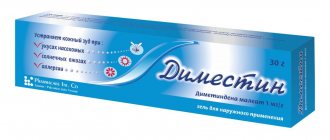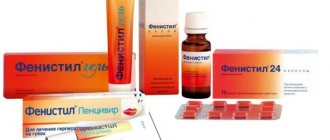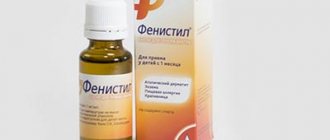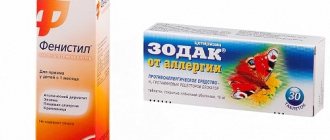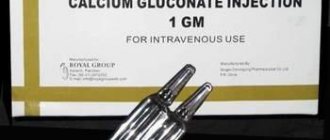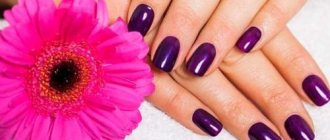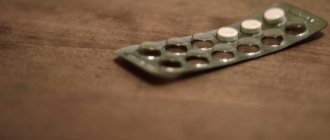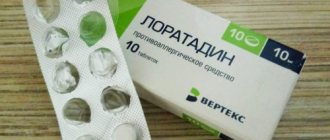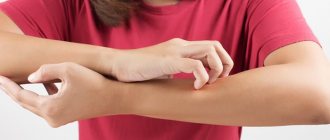Appointment with reservation
A doctor can prescribe Fenistil to a pregnant woman only in cases of extreme necessity - when the allergy poses a threat to the health or life of the woman.
But at the same time, be sure to warn her about the inevitability of possible consequences for the fetus. The final decision on taking medication rests with the expectant mother: she must make a difficult choice between the health and life of the baby and her own. To save a woman from such torment, it is advisable to find analogues of Fenistil - less dangerous and more effective.
Therapeutic effect
Dimetindene maleate is the active component of all dosage forms. It is a non-selective histamine H1 receptor inhibitor. The dosage of the active substance in the packages is different. Depending on the method of application, the product exhibits local and systemic effects. Additional composition depends on the dosage form. Auxiliary components improve the absorption of the active component.
A small tube contains a transparent substance. 100 g of gel contains 100 mg of the active ingredient. Excipients include propylene glycol, distilled water, carbopol, sodium hydroxide solution, benzalkonium chloride and ethylenediaminetetraacetic acid disodium salt. This topical remedy is suitable for children and adult patients.
The gel does not contain alcohol or dyes. The drug is quickly absorbed into the skin after application. Has a cooling effect.
The applicator package contains a translucent liquid substance. One gram of emulsion contains 1 mg of active substance. Excipients include benzalkonium chloride, phenylcarbinol, ionol, sodium hydroxide solution, propylene glycol, paraffin, cetostearomacrogol, carbopol, cocoyl caprylocaprate, water and disodium ethylenediaminetetraacetic acid. The emulsion is suitable for topical use.
It is a colorless, odorless liquid. One milliliter of medicine contains 1 mg of the active ingredient. Excipients include sodium hydrogen phosphate, propylene glycol, water, sodium saccharinate, citric acid monohydrate, bonzoic acid and ethylenediaminetetraacetic acid disodium salt. Drops are intended for oral administration.
Dimetindene maleate exhibits antihistamine, analgesic and anti-inflammatory properties. This chemical compound disrupts the interaction of histamine with cellular receptors, due to which the development of the immunological reaction stops. The drug does not eliminate the cause of allergy development and is suitable only for symptomatic therapy.
- Anti-inflammatory effect. Dimetindene maleate reduces vascular permeability, which is why inflammatory mediators stop getting into the tissues. The product reduces the severity of edema and eliminates redness of the integumentary tissue.
- Antipruritic effect. Skin itching due to an allergic reaction is caused by irritation of pain receptors. Alleviating the inflammatory process helps the patient get rid of the unpleasant symptom.
- Antibradykinin action. Bradykinin increases pain and negatively affects the condition of blood vessels during the inflammatory response. The drug inhibits the activity of this peptide.
- Analgesic effect. The anesthetic properties of the drug are due to the action of the active component and excipients.
- Anticholinergic properties. Strengthen the effectiveness of symptomatic therapy.
The active substance is dimethindene maleate.
We suggest you familiarize yourself with what means you can remove papillomas
Excipients are different for each form of the drug.
It has anti-allergenic and mild sedative effects. The therapeutic effect is observed 2-2.5 hours after application. Penetrates into tissues, 90% binds to plasma proteins.
Metabolized in the liver. Excreted in urine and bile.
Fenistil: instructions, composition, indications, action, reviews and prices
Fenistil is prescribed for the prevention and treatment of allergic reactions. This is an antihistamine that can be used in childhood and adulthood.
The use of this drug helps to get rid of the unpleasant symptoms of immunological reactions, including skin itching and redness of the integumentary tissue.
With constant relapses of allergies, the drug helps reduce the frequency of symptoms. Sold in several dosage forms.
Fenistil and other first-generation antihistamines rarely cause severe side effects.
Composition and release form
Dimetindene maleate is the active component of all dosage forms. It is a non-selective histamine H1 receptor inhibitor. The dosage of the active substance in the packages is different. Depending on the method of application, the product exhibits local and systemic effects. Additional composition depends on the dosage form. Auxiliary components improve the absorption of the active component.
The medicine is sold in the form of gel, drops and emulsion.
Fenistil in gel form
A small tube contains a transparent substance. 100 g of gel contains 100 mg of the active ingredient. Excipients include propylene glycol, distilled water, carbopol, sodium hydroxide solution, benzalkonium chloride and ethylenediaminetetraacetic acid disodium salt. This topical remedy is suitable for children and adult patients.
Gel
The gel does not contain alcohol or dyes. The drug is quickly absorbed into the skin after application. Has a cooling effect.
Fenistil in the form of an emulsion
The applicator package contains a translucent liquid substance. One gram of emulsion contains 1 mg of active substance.
Excipients include benzalkonium chloride, phenylcarbinol, ionol, sodium hydroxide solution, propylene glycol, paraffin, cetostearomacrogol, carbopol, cocoyl caprylocaprate, water and disodium ethylenediaminetetraacetic acid. The emulsion is suitable for topical use.
The roll-on applicator makes it easier to apply the emulsion to the affected areas of the skin.
Fenistil in the form of drops
It is a colorless, odorless liquid. One milliliter of medicine contains 1 mg of the active ingredient. Excipients include sodium hydrogen phosphate, propylene glycol, water, sodium saccharinate, citric acid monohydrate, bonzoic acid and ethylenediaminetetraacetic acid disodium salt. Drops are intended for oral administration.
The oral form of the medicine is suitable for infants older than one month. Does not contain ethanol and dyes.
Therapeutic effect
Dimetindene maleate exhibits antihistamine, analgesic and anti-inflammatory properties. This chemical compound disrupts the interaction of histamine with cellular receptors, due to which the development of the immunological reaction stops.
The drug does not eliminate the cause of allergy development and is suitable only for symptomatic therapy. The use of drops, gel or emulsion helps to cope with the most unpleasant manifestations of pathology, including itchy skin.
The therapeutic effect develops within several tens of minutes and lasts for 4-5 hours.
An allergic reaction is caused by the entry into the patient’s body of a certain substance that is recognized by the immune system as a threat. It could be fluff, pollen or a speck of dust.
An inflammatory mediator (histamine) is released, interacting with cellular receptors and triggering a cascade of adverse changes.
The main symptoms of an allergy appear, including skin itching, redness of the integumentary tissues and pain.
Additional properties
- Anti-inflammatory effect. Dimetindene maleate reduces vascular permeability, which is why inflammatory mediators stop getting into the tissues. The product reduces the severity of edema and eliminates redness of the integumentary tissue.
- Antipruritic effect.
Skin itching due to an allergic reaction is caused by irritation of pain receptors. Alleviating the inflammatory process helps the patient get rid of the unpleasant symptom. - Antibradykinin action.
Bradykinin increases pain and negatively affects the condition of blood vessels during the inflammatory response. The drug inhibits the activity of this peptide. - Analgesic effect. The anesthetic properties of the drug are due to the action of the active component and excipients.
- Anticholinergic properties. Strengthen the effectiveness of symptomatic therapy.
Drops
Topical forms of the drug have a local effect on inflamed tissue. Taking drops helps reduce the manifestations of allergies in various anatomical structures.
Indications for use of Fenistil
An allergic reaction is the main indication. The product can be used to eliminate occasional manifestations of allergies and treat the disease.
Symptomatic indications for the use of dimethindene maleate include skin redness, swelling and skin rash. The choice of dosage form of the drug should depend on the manifestations of the pathological condition and the characteristics of the medical history.
It is recommended that you trust your doctor to prescribe the right medication. The specialist will conduct a diagnosis and clarify the cause of the complaints.
Indications for use of drops
- Hives. The main symptom of this allergic disease is the appearance of red blisters on the skin, reminiscent of a burn. Skin changes are accompanied by itchy pain.
- Allergic rhinitis is an inflammation of the nasal mucosa of an immunological nature.
Symptoms of the disease include nasal congestion, excess mucus production, and discomfort in the nasal passages. - Hay fever. Symptoms of the pathology include redness of the conjunctiva of the eyes, weakness, runny nose and skin rashes. The attacks are seasonal.
- Allergic reaction to food and medications. This condition causes a variety of symptoms, including abdominal pain and skin rashes.
- Angioedema is an immunological disorder.
Contact of integumentary tissues with an allergen is accompanied by swelling of the skin and mucous membranes. - Diseases accompanied by itchy skin. These are different forms of dermatitis, eczema, rubella, measles and other diseases. Burning and itching also occur due to an insect bite.
- Reducing the risk of developing allergies as part of complex therapy of the underlying disease.
The systemic effect of the drops is suitable for the treatment of most pathologies of an allergic nature.
Indications for use of gel and emulsion
- Itchy pain in the skin area, developing against the background of eczema, insect bites, dermatitis, urticaria and other pathological conditions of an allergic nature.
- Burn of integumentary tissue due to excessive exposure to sunlight.
- Minor chemical burns of domestic or industrial origin.
The absence of a systemic effect can be a plus, since it reduces the severity of unwanted reactions.
Contraindications to the use of drops
- Hypersensitivity of the body to any component.
- Breast-feeding.
- Angle-closure glaucoma.
- Immunological inflammation of the bronchi (bronchial asthma).
- The child is up to one month old.
- First trimester of pregnancy.
- BPH.
Children's age from one month to a year, obstructive pulmonary pathology and epilepsy are not considered contraindications, however, in the presence of these conditions, antihistamines should be used with caution.
Contraindications to the use of gel and emulsion
- Angle-closure glaucoma.
- Hypersensitivity to any component.
- Prematurity and the age of the child up to one month.
- BPH.
The topical form of the drug can be used in the first trimester of pregnancy and during lactation, but before doing this you should consult a doctor. Treatment must be carried out carefully.
Side effects of drops
- Swelling in the facial area.
- Muscle tension (spasms).
- Breathing problems.
- Acute immunological reactions.
- Fatigue and drowsiness.
- Nausea and vomiting.
- Stomach ache.
- Loose stools.
- Dry mucous membranes.
- Headache and dizziness.
- Irritability and anxiety.
Drowsiness, irritability, weakness and other side effects associated with the functioning of the nervous system often occur during the use of the drug.
If unpleasant symptoms do not disappear, you need to make an appointment with a doctor.
Side effects of gel and emulsion
- Dry skin.
- Skin rashes, itching.
- Burning skin.
Unpleasant symptoms usually affect only the area of application of the topical remedy.
Instructions for use of Fenistil
The drug must be used strictly according to indications. If skin reactions and other unpleasant symptoms occur for the first time, it is recommended to visit a doctor before starting therapy.
Dimetindene maleate is only suitable for symptomatic relief, so using a topical or oral medication will not permanently eliminate the problem.
Symptoms of an allergic reaction may return a few hours after using the medicine.
Using drops
- Patients aged from one month to twelve years. The daily dosage is determined by the child’s body weight. Two drops per kilogram. The received dose is divided into three doses per day.
- Patients over twelve years of age: from 60 to 120 drops per day. The daily dose should be divided into three single doses during the day.
- If drowsiness occurs during treatment, it is recommended to take drops before bed and in the morning.
For infants, drops should be prescribed by a doctor. Self-medication is unacceptable.
Using gel and emulsion
The liquid is used for external treatment of affected surfaces. It is recommended to apply a small amount of emulsion or gel to the surface of the skin two to four times a day. If the patient suffers from extensive skin rashes and severe pain, a doctor should be consulted. The simultaneous use of topical and oral forms of the drug is possible.
additional information
- The use of drops enhances the therapeutic effect of drugs that depress the nervous system. These are tranquilizers, sleeping pills, antidepressants, anticonvulsants and other medications.
- Tricyclic antidepressants and m-anticholinergic blockers, when taken simultaneously with drops, increase the risk of increased intraocular pressure and urinary problems.
- If the patient is taking any medications, you should consult a doctor before using the drops.
- After treating the skin with a topical agent, exposure to sunlight should be avoided.
- The components of the gel and emulsion may cause irritation and symptoms of dermatitis.
- Do not treat large surface areas of skin in small children.
- Fenistil should not be taken together with procarbazine.
- Therapy in childhood increases the excitability of the nervous system.
- Drops can be added to baby food.
- The drug reduces the speed of psychomotor reactions.
Driving during therapy should be done with caution.
Before use, you should read the complete instructions, which can be found in the package.
Fenistil's analogs
Dimetindene is a direct analogue of the drug containing dimethindene maleate as an active ingredient. Available in the form of drops and gel.
Indirect analogues with other active ingredients:
- Advantan is a cream with antiallergic properties.
- Tavegil is an antihistamine.
- Claritin is an antiallergic drug in the form of tablets and syrup.
Analogue
Analogues with other active ingredients differ in contraindications, features of action and instructions.
Reviews and prices
Allergists and other doctors speak well of the medicine. There is less severity of adverse reactions compared to other antihistamines. Patients note the rapid development of the therapeutic effect and good tolerability.
The average price of the emulsion is 320 rubles. A package of gel (50 g) can be purchased for 450-600 rubles. The average price of drops is 390 rubles.
Fenistil is suitable for the symptomatic treatment of allergies and reducing the risk of exacerbations. The drug should be taken with caution in childhood and while pregnant.
Source: https://fenistil-gel.ru/
Gel, drops, capsules
Fenistil is produced in several forms, so less experienced doctors begin to look for an alternative between the options: gel, capsules or drops. Such a search, as a result, leads to one thing: a woman must make a difficult choice, since even the external use of Fenistil is not as safe as we would like.
It is best to completely exclude the drug as a means of therapy during the patient’s pregnancy and treat her with other means and methods. If an allergy haunts a woman too obsessively, it is permissible to alleviate the symptoms before delivery, and after the birth of the baby, eliminate the source of infection using strong drugs, including Fenistil.
If there is a threat to life (for example, Quincke's edema), the doctor may prescribe Fenistil capsules or drops, but very carefully, subject to strict adherence to the dosage.
As for the gel, its purpose depends on the area and degree of the lesion - applying the gel to large areas of the skin is prohibited, just as you should not use Fenistil in case of severe irritation and bleeding.
Fenistil during pregnancy: features of use. Fenistil drops during pregnancy
This drug is used to treat allergic reactions such as urticaria, seasonal rhinitis, edema, hay fever, and drug allergies. In addition, Fenistil is prescribed for skin itching, dermatitis, measles, chickenpox, rubella and common insect bites.
The drug may have a mild sedative effect. The therapeutic effect is observed 3 hours after application or use. The medicine is absorbed into tissues almost completely and binds to blood proteins. It settles in the liver and is excreted from the body with bile and urine.
The drug is available in the forms of gel, capsules or drops. However, the expectant mother needs to know that even in gel form the medicine is not as harmless as it seems.
Among the side effects, the manufacturer identifies anaphylactic reactions, swelling of the face and muscles, rash, unreasonable agitation, nausea, headache and dizziness.
Indications for use of Fenistil during pregnancy
Fenistil during pregnancy is prescribed to correct the condition of a woman who has developed an allergy to a specific allergen.
Indications:
- dermatosis;
- hives;
- eczema;
- burns;
- allergies to medications;
- food allergies;
- sunburn;
- Quincke's edema;
- insect bites;
- hay fever
Is it possible and how much to take?
When taking medication, you should be guided by the main rule - the less you take, the better for your health.
But, in the case of an acute allergic reaction, drugs can be taken in short courses from seven to ten days in order to block the main symptoms.
If the symptoms disappear before the end of the course, you can stop taking the medicine ahead of schedule. It follows that Fenistil can be used in shorter courses, and is effective when it comes to relieving an acute allergic attack.
In case of seasonal allergies, it is allowed to continuously use Fenistil for twenty-five days, however, it is better to avoid such a long course of treatment, and for prevention choose another antihistamine option.
How to take Fenistil during pregnancy in the 1st, 2nd, 3rd trimester, reviews
Fenistil in the first trimester of pregnancy
As already mentioned, Fenistil is approved for expectant mothers. In order for its use to be safe, it is advisable to avoid oral forms and correlate the medication with the duration of pregnancy - the features of its effect are quite different.
The first trimester (up to week 12) is a contraindication for taking any form of Fenistil.
Read: What to do if you have diarrhea during your period
For severe allergic manifestations, the use of a gel or emulsion is allowed. Drops are used only as a last resort, when the benefit to the mother is greater than the risk to the fetus.
The use of capsules is strictly prohibited - they are not more effective than drops, but are more dangerous for the unborn baby.
In the second trimester (13-24 weeks) it is permissible to use external forms of the drug. They should be used strictly according to the instructions; you must not violate them - this can have a bad effect on the health of the unborn baby.
The optimal number of applications is 2 per day. Drops are used for severe allergic reactions, based on the same rule that the benefit must outweigh the risk. Capsules are strictly not recommended.
By the third trimester (after 24 weeks), the rules for using the drug do not change - it must be used strictly according to indications and in accordance with the instructions. The gel should not be applied to large areas of skin. In addition, the rule that the affected areas should not be exposed to ultraviolet rays should be strictly observed.
After the birth of a baby, it is undesirable to use Fenistil during lactation, especially in oral forms. If indicated, you can apply a gel or emulsion, but in no case should you treat nipples with them - this will negatively affect the baby’s health. If there is a need for treatment with Fenistil, you can interrupt lactation and transfer the baby to artificial feeding.
As for the use of the drug in children, the emulsion, gel and drops can be used from 1 month, but strictly according to indications. Of the external forms, emulsion is preferable, since it dries faster and there is less risk of it accidentally getting into the mouth from the treated areas. Drops can only be used if prescribed by a pediatrician. Capsules are not used in children under 12 years of age.
Regardless of the stage of pregnancy, there are general precautions. It is advisable to give preference to dosage forms for external use. You cannot use capsules if there is a need to take Fenistil orally; drops are best.
If you feel worse, you should immediately stop taking the drug and consult a doctor. You must take the drug strictly according to the instructions and prescriptions of the doctor; self-medication is dangerous.
Read: Balanced nutrition for pregnant and lactating women
Dosage forms for external use should not come into contact with mucous membranes, eyes, nose and mouth, especially in children.
Since the side effects of Fenistil include decreased attention and drowsiness, during treatment with this drug you should avoid activities that require increased alertness and reaction speed.
It should be noted that during pregnancy, attentiveness is also reduced, so you should not drive, engage in extreme sports, and if the work involves risk, it is better to take sick leave during treatment.
Reviews from patients about the use of Fenistil indicate that this remedy is very effective and quite safe during pregnancy if the instructions are strictly followed.
However, pitfalls also emerge. For example, the fact that hypersensitivity to its components, which was not present before pregnancy, may develop in the expectant mother.
In such cases, it sometimes helps to change the dosage form - they contain different excipients, and if they are the allergen, then allergic manifestations are likely to stop.
Such experiments are permissible only for mild forms of hypersensitivity.
Composition, action, pharmacokinetics
The active substance is dimethindene maleate .
Excipients are different for each form of the drug.
It has anti-allergenic and mild sedative effects. The therapeutic effect is observed 2-2.5 hours after application. Penetrates into tissues, 90% binds to plasma proteins.
Metabolized in the liver. Excreted in urine and bile.
How to take Fenistil - instructions
The rules for using Fenistil are determined by its dosage form. The duration of treatment and the optimal dosage depend on the gestational age, the form of the medication, the type of allergy and the characteristics of the female body.
Fenistil gel during pregnancy, as well as ointment and emulsion, are applied to cleansed skin in areas with allergic manifestations. A small pea of the drug is rubbed into the skin every 6-8 hours (less often). In case of severe allergies, it is advisable to combine the gel with oral administration of drops.
Important! It is allowed to prescribe Fenistil gel during pregnancy from the 1st trimester. But in the early stages, it is recommended to apply a local application of the gel no more than 3 times every 24 hours.
The use of Fenistil gel has its own characteristics:
- After applying the gel, the skin should not be exposed to sunlight.
- The presence of propylene glycol can cause irritation, so the gel is not applied to damaged areas.
- Gel/cream is incompatible with other antihistamines for external use.
Fenistil drops are taken orally during pregnancy. The daily dose is 6 g, which is equivalent to 30 drops three times a day. If a woman experiences increased drowsiness, the daily dose is redistributed: 20 drops in the morning and 40 before bed.
On a note! Mixing drops with juices or tea, or subjecting them to heat treatment is prohibited.
Fenistil tablets are prescribed extremely rarely during pregnancy. If such a need arises, the woman is prescribed a minimum dose with a therapeutic effect - 1 tablet per day. During treatment, the woman is advised to limit driving.
Important! The doctor sets the duration of treatment at his own discretion, but during pregnancy it is advisable to reduce it to a minimum - no longer than 5-7 days.
Side effects
The drug can cause side effects from the central nervous system, gastrointestinal tract and respiratory system, expressed in dizziness and headache, drowsiness and excitability, nausea and stomach pain, exacerbation of peptic ulcers and gastritis, a feeling of a “stone” in the chest, breathing problems, swelling .
Gel, drops, capsules
Fenistil is produced in several forms, so less experienced doctors begin to look for an alternative between the options: gel, capsules or drops. Such a search, as a result, leads to one thing: a woman must make a difficult choice, since even the external use of Fenistil is not as safe as we would like.
Indications for use of Fenistil
An allergic reaction is the main indication. The product can be used to eliminate occasional manifestations of allergies and treat the disease. Symptomatic indications for the use of dimethindene maleate include skin redness, swelling and skin rash. The choice of dosage form of the drug should depend on the manifestations of the pathological condition and the characteristics of the medical history. It is recommended that you trust your doctor to prescribe the right medication. The specialist will conduct a diagnosis and clarify the cause of the complaints.
- Hives. The main symptom of this allergic disease is the appearance of red blisters on the skin, reminiscent of a burn. Skin changes are accompanied by itchy pain.
- Allergic rhinitis is an inflammation of the nasal mucosa of an immunological nature. Symptoms of the disease include nasal congestion, excess mucus production, and discomfort in the nasal passages.
- Hay fever. Symptoms of the pathology include redness of the conjunctiva of the eyes, weakness, runny nose and skin rashes. The attacks are seasonal.
- Allergic reaction to food and medications. This condition causes a variety of symptoms, including abdominal pain and skin rashes.
- Angioedema is an immunological disorder. Contact of integumentary tissues with an allergen is accompanied by swelling of the skin and mucous membranes.
- Diseases accompanied by itchy skin. These are different forms of dermatitis, eczema, rubella, measles and other diseases. Burning and itching also occur due to an insect bite.
- Reducing the risk of developing allergies as part of complex therapy of the underlying disease.
- Itchy pain in the skin area, developing against the background of eczema, insect bites, dermatitis, urticaria and other pathological conditions of an allergic nature.
- Burn of integumentary tissue due to excessive exposure to sunlight.
- Minor chemical burns of domestic or industrial origin.
Not all patients can take drops and apply topicals to the surface of the skin. Some diseases and conditions increase the risk of complications during drug therapy. The presence of any contraindication indicates the impossibility of using Fenistil.
- Hypersensitivity of the body to any component.
- Breast-feeding.
- Angle-closure glaucoma.
- Immunological inflammation of the bronchi (bronchial asthma).
- The child is up to one month old.
- First trimester of pregnancy.
- BPH.
- Angle-closure glaucoma.
- Hypersensitivity to any component.
- Prematurity and the age of the child up to one month.
- BPH.
We suggest you familiarize yourself with Diflucan for thrush: application, how to take tablets, how long it will take, how to take capsules and suppositories for men
For pregnant patients, the main indication remains angioedema, since an allergic manifestation in such a dangerous form is a direct threat to life.
Other allergic reactions:
- hives;
- itching;
- hay fever;
- allergic runny nose
You can overcome it with the help of other, less aggressive medications, or folk remedies.
The medicine Fenistil has the following contraindications. In particular, Fenisti drops should not be taken if you have a high sensitivity threshold to the drug, are in the first trimester of pregnancy or are breastfeeding, or have prostatic hyperplasia or angle-closure glaucoma.
Fenistil capsules - should not be taken if you are hypersensitive to the drug.
Fenistil gel - should not be used in case of hypersensitivity to the drug, in children under one month of age, in case of closed-angle glaucoma and in case of prostatic hyperplasia.
Women during pregnancy and lactation are allowed to use Fenistil, subject to medical supervision and guidance.
fenistil drops during pregnancy
The kids have grown up, it's time to renew themselves.
And so, let's start with the fact that this is MY first aid kit, I do not impose anything on anyone.
All adults and everyone decides for themselves, I’m just sharing information.
Antibiotic. Only Suprax helps Gris; for me, azithromycin/sumamed 500 mg is in my medicine cabinet. I would like to add that I give the antibiotic to the child ONLY for a sore throat, ttt, there were no other serious illnesses. Accordingly, we always have this particular drug in our medicine cabinet, and it also comes with us on trips.
Poisoning\rotovirus.
Enterosgel paste (you can replace it with anything similar to the action of the sorbent, from coal to polysorb)
Enteroferil suspension (capsules for adults) - antimicrobial effect.
Motilium/Motilak is an antiemetic, it also helps with bloating. For a child, Motilium in a suspension, for myself I take Motilak in a tub, it’s cheaper. Another anti-emetic we have is Cerucal, for the most desperate - injections. I’ll explain why - vomiting is very dangerous, because... there is a huge loss of fluid, it’s no secret that with rotavirus vomits constantly... And the suspension that the child takes orally, often the body simply does not have time to absorb... Therefore, with frequent vomiting and for those who are not afraid to give injections (by the way, now there is a special pistol-pen for these manipulations) namely ampoules. For adults, cerucal in TB is a great help when “helicopters” after a large number of strong drinks do not allow you to sleep))))
Regidron - everything is clear here, we replenish the water-salt balance in the body.
Smecta\neosmectin\maalox\espumisan, etc. - all this is in the medicine cabinet in small quantities, because not really important.
From “fixing” enterol and bifiform (USUAL in capsules). They normalize stools without harm. We take bifiform during the current. at least weeks after the incident.
Creon\Microzyme, etc. are important in the first days after poisoning/rotovirus, they help digest food. Why exactly they, and not Mezim-it’s EASIER to give a child the granules that are inside the capsule, and not the whole tablet. Grey, I can’t swallow any pill at all...
De-nol, this is mainly for adults, helps “gastritis sufferers” at the very peak of an exacerbation, or after poisoning.
Well, no-spa relieves spasms.
p.s. THESE ARE ALL RECOMMENDATIONS for people who are confident in their abilities and who can keep the whole situation under control. Rotovirus and poisoning in severe forms are very dangerous and I strongly recommend that you still consult a doctor even abroad.
Throat\ears\nose and tail (joke)
Nazivin, Bioparox, Tantum-verde, Miramistin, Yox, Imudon, Grimidin S, for such “tonsillitis chronics” as me - soda, salt and iodine rinse are the best remedy))))
sofradex (eyes and ears), otipax (ears) and ciprolet (eyes), ophthalmoferon (eyes). Eyes are conjunctivitis, I am aware that conjunctivitis can be both viral and bacterial, and bacterial, in turn, is also different, so , for everyone interested, read the instructions)))
At sea I usually DO NOT take sea water from a pharmacy, but at home it is available.
By the way, sea water. In the form of simple sprays, such as aqua-maris, where the stream is small - this is prevention, or, well, moisturizing the mucous membrane. BUT, you cannot use it daily, weekly and constantly, because it affects the “normal functioning” of your mucous membrane . There are devices like “Dolphin”, it is also dangerous, but at the same time wonderful) This thing is not recommended for children/adults with frequent otitis media, with a short auditory tube, etc., because the jet is very powerful and “pierces right through”. I’ll tell you for myself, it helps me, Gris and my husband very well. It’s very convenient that Dolphin actually washes away all the accumulated mucus.
Antipyretic. Everyone here probably already knows about everything) For some, candles in the butt, for others, syrup in the mouth. We have both nurofen in syrup and ALWAYS nimesulide. For children in syrup (although Gris in syrup still doesn’t help) and Nimesil powders. We don’t use Paracetamol, that’s the way it is. For children who are difficult to tolerate a temperature of 40, of course, consult with doctors before the trip, they may recommend an amp. analgin, diphenhydramine and no-spa.
Cough. Of course, you can’t take all kinds of syrups with you on a trip, that’s why we have Erespal, Sinekod (drops). And of course, an ultrasound inhaler with sodium chloride and berodual included... By the way, I wanted to share - now there is a very cool type of inhaler, the MESH inhaler. VERY small, compact and convenient. I'm thinking of replacing our ultrasonic AND with it.
I always take Doctor Mom ointment for coughs.
Wounds\burns. That’s how much I read, listen to my friends and am amazed, why don’t you apply PROTECTIVE cream to your children at sea?????? Is everyone hoping for “maybe”? And then the posts “we burned out, we were sitting in the room.” Everything is elementary - simple - SPF +50 filter and a good manufacturer (I never change my beloved La Roche Pose).
So first thing is sunscreen!
Three times the panthenol in the spray!!! It is in the spray, and not in the ointment, because it is not recommended to touch the burn surface with your hands! It’s better to immediately put the spray in the refrigerator upon arrival, cold pain relief is better. Olazol is also a good spray, it contains sea buckthorn oil and other antibacterial ingredients.
Miramistin in a spray was already written in the throat, it can be used here naturally - we first treat any wound surface with an antiseptic.
Actovigin\solcoseryl gel for a “fresh” wound will perfectly protect against contamination and heal. For a “dry” wound, actovigin or solcoseryl ointment. Well, my favorite Traumeel, I always have it on hand.
I would like to remind you about brilliant green that you can “pour” it into a wound, and we only treat the edges with iodine. So usually I have liquid brilliant green, and iodine in a pencil.
Peroxide, wipes, ointment wipes with antiseptics (like Branolind), bandages, plasters, etc. - all this goes without saying.
Allergies - fenistil / psilobalm - in gels, they perfectly relieve redness and itching on the skin. Inside - whoever is used to using it)) we have our favorite Zodak in drops for Gris and in TB for adults.
Vinylin and Cholisal gel are also always with us now; we have already experienced stomatitis a couple of times)
Well, from the “adult first aid kit” - nolicin\monural\biseptol (inflammation of the bladder, or simply cystitis), ketorol\ketanov - toothache, spazgan, nurofen, novigan, instantly what you like best - headache. Alka-Seltzer, aspirin C, pregnancy tests, postinor, escapelle, flucostat, etc. I won’t describe it either
And yes, smart people who will climb into my post, which, BY THE WAY, was published in MY diary, with their advice - “but in America this drug was banned,” “you need to go to the doctors,” etc. statements will be sent to BAN.
Consider me a smug bitch, even though that’s what I am...
Peace, love and pleasant travels without pain to everyone!
p.s. Maybe I forgot something else - ask))
Side effects
Medicinal substances act not only on damaged tissues. The components of any drug can penetrate other anatomical structures and cause undesirable effects. Antihistamines can also cause allergies if the patient's immune system is sensitive to the active or auxiliary component.
Skin rashes may be a side effect
- Swelling in the facial area.
- Muscle tension (spasms).
- Breathing problems.
- Acute immunological reactions.
- Fatigue and drowsiness.
- Nausea and vomiting.
- Stomach ache.
- Loose stools.
- Dry mucous membranes.
- Headache and dizziness.
- Irritability and anxiety.
- Dry skin.
- Skin rashes, itching.
- Burning skin.
The drug can cause side effects from the central nervous system, gastrointestinal tract and respiratory system, expressed in dizziness and headache, drowsiness and excitability, nausea and stomach pain, exacerbation of peptic ulcers and gastritis, a feeling of a “stone” in the chest, breathing problems, swelling .
Fenistil's analogs
1st trimester
Before the 13th week of pregnancy, use is prohibited - the degree of danger to the embryo is too high.
2nd trimester
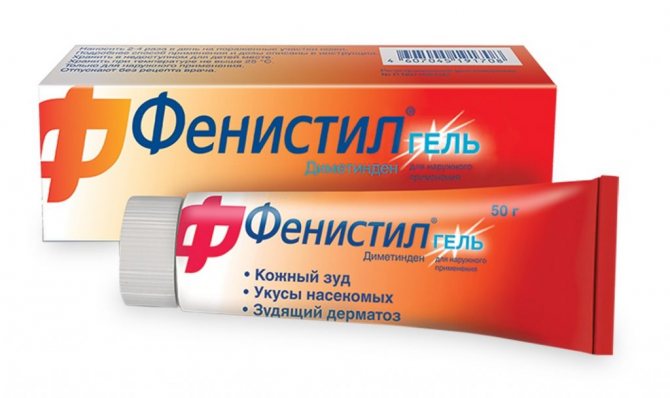
Use with caution when there is a clear threat to the life of the mother; the doctor is obliged to warn about the consequences for the fetus.
3rd trimester
The drug is prescribed extremely rarely, only if emergency treatment is necessary when a pregnant woman develops Quincke's edema. Before prescribing, the doctor consults the pregnant woman about the possible consequences.
The drug must be used strictly according to indications. If skin reactions and other unpleasant symptoms occur for the first time, it is recommended to visit a doctor before starting therapy. Dimetindene maleate is only suitable for symptomatic relief, so using a topical or oral medication will not permanently eliminate the problem. Symptoms of an allergic reaction may return a few hours after using the medicine.
- Patients aged from one month to twelve years. The daily dosage is determined by the child’s body weight. Two drops per kilogram. The received dose is divided into three doses per day.
- Patients over twelve years of age: from 60 to 120 drops per day. The daily dose should be divided into three single doses during the day.
- If drowsiness occurs during treatment, it is recommended to take drops before bed and in the morning.
The liquid is used for external treatment of affected surfaces. It is recommended to apply a small amount of emulsion or gel to the surface of the skin two to four times a day. If the patient suffers from extensive skin rashes and severe pain, a doctor should be consulted. The simultaneous use of topical and oral forms of the drug is possible.
- The use of drops enhances the therapeutic effect of drugs that depress the nervous system. These are tranquilizers, sleeping pills, antidepressants, anticonvulsants and other medications.
- Tricyclic antidepressants and m-anticholinergic blockers, when taken simultaneously with drops, increase the risk of increased intraocular pressure and urinary problems.
- If the patient is taking any medications, you should consult a doctor before using the drops.
- After treating the skin with a topical agent, exposure to sunlight should be avoided.
- The components of the gel and emulsion may cause irritation and symptoms of dermatitis.
- Do not treat large surface areas of skin in small children.
- Fenistil should not be taken together with procarbazine.
- Therapy in childhood increases the excitability of the nervous system.
- Drops can be added to baby food.
- The drug reduces the speed of psychomotor reactions. Driving during therapy should be done with caution.
We invite you to familiarize yourself with White spots on the skin. What is it and how to treat it, the causes, what is the name of the disease in adults and children. How to get rid of spots on the body at home
Dimetindene is a direct analogue of the drug containing dimethindene maleate as an active ingredient. Available in the form of drops and gel.
Indirect analogues with other active ingredients:
- Advantan is a cream with antiallergic properties.
- Tavegil is an antihistamine.
- Claritin is an antiallergic drug in the form of tablets and syrup.
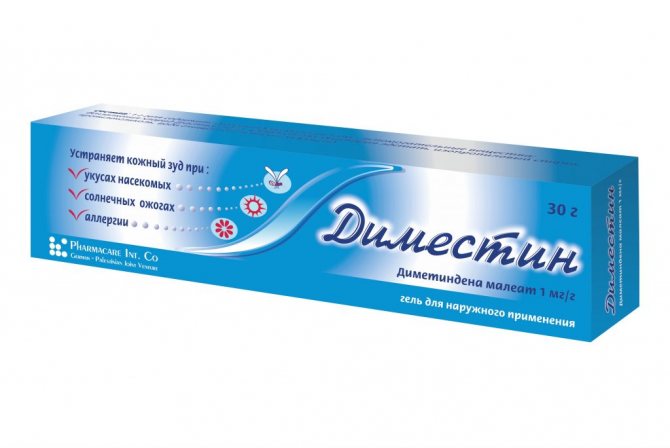
Analogues with other active ingredients differ in contraindications, specific action and instructions.
Fenistil during pregnancy: features of use
It is very difficult to recover from allergies during an “interesting” situation. There is a small range of medications that are prescribed by gynecologists during pregnancy.
Among them is Fenistil. However, there are some caveats, which will be discussed below.
Briefly about the drug
This drug is used to treat allergic reactions such as urticaria, seasonal rhinitis, edema, hay fever, and drug allergies. In addition, Fenistil is prescribed for skin itching, dermatitis, measles, chickenpox, rubella and common insect bites.
The drug may have a mild sedative effect. The therapeutic effect is observed 3 hours after application or use. The medicine is absorbed into tissues almost completely and binds to blood proteins. It settles in the liver and is excreted from the body with bile and urine.
The drug is available in the forms of gel, capsules or drops. However, the expectant mother needs to know that even in gel form the medicine is not as harmless as it seems.
Among the side effects, the manufacturer identifies anaphylactic reactions, swelling of the face and muscles, rash, unreasonable agitation, nausea, headache and dizziness.
Why do doctors prescribe it to expectant mothers?
If an allergy has a strong impact on a woman who is carrying a child, and already threatens the condition of both the mother and the unborn fetus, doctors prescribe Fenistil. It blocks allergic reactions in the body.
Of course, Fenistil refers to drugs that have a strong effect on the body and are absorbed into the tissues.
If there is a threat to the life of the expectant mother, namely Quincke's edema has begun to develop, then doctors decide to prescribe Fenistil. These will be tablets or drops. The dosage must be carefully observed.
The gel is usually prohibited from being applied to too large affected areas of the epidermis. Because on open wounds or overly irritated areas, the drug may not have a therapeutic effect, but provoke the progression of the disease.
Fenistil has a number of contraindications. You should not take drops if the expectant mother is highly sensitive to the main components of the drug, is in the first months of pregnancy or is breastfeeding. Drops are also contraindicated for children under one year of age, people suffering from bronchial asthma and lung diseases.
Can I drink or apply it during pregnancy?
In general, doctors do not prohibit the use of Fenistil in an “interesting” situation. To make its use safer, you should avoid pills and always follow trimester recommendations.
It is worth noting that the drug is prescribed when absolutely necessary, and doctors always discuss the possible consequences for the fetus. At the same time, explaining irreversible changes for the baby’s development. The final decision to take or refuse the drug is made by the expectant mother. To avoid such a choice, doctors, as a rule, look for analogues of the drug - less dangerous ones.
Fenistil has an antipruritic and anti-inflammatory effect. It reduces irritation, but has a sedative effect on the body.
The drug may enhance the effect of other medications, especially sleeping pills. If you take them at the same time, you may experience a decrease in reaction time, severe drowsiness, and slowed psychomotor skills.
If taken in combination with antidepressants, the risk of high intraocular pressure increases.
An overdose of the drug may also occur - flashes of aggression, unfounded agitation, convulsions, dry mouth, inhibited reaction, tachycardia, low blood pressure.
The danger of taking it lies in the side effects. However, in less dangerous periods of pregnancy, the drug can be prescribed when the baby’s placenta is already formed and protects it from external factors that can affect the development of the fetus.
Methods of use in different cases for pregnant women by trimester
During pregnancy, the tablet form of Fenistil is best avoided. In general, the drug can be used, but it is better in the form of ointments. At different periods of bearing a child, a woman’s body changes; the fetus in the second trimester is already protected by the placenta.
Let's figure out by trimester whether it is possible to treat allergy symptoms with Fenistil at different periods of pregnancy.
1st trimester. Before the 12th week, Fenistil in any form of release is prohibited. The fetus is not protected and is influenced by what the mother carrying the child consumes. So during this period of pregnancy it is better to replace the medicine with other analogues. If a severe allergic reaction begins, then it is permissible, as a last resort, to use an emulsion.
2nd trimester. During this period, ointments can be used. However, there is a nuance - use them strictly according to the instructions, and in no case overdose. You can apply the ointment to the skin no more than 2 times a day.
If more, it can affect the development of the fetus. Drops during this period of pregnancy are used only when absolutely necessary. Otherwise it is dangerous for the baby. Because the drug is completely absorbed into the tissue and reaches the baby.
Tablets are not recommended for use.
3rd trimester. The rules for using Fenistil during this period of pregnancy are similar to the rules in the previous, 2nd trimester.
Nothing changes - strictly follow the instructions, follow the doctor’s requirements. You need to pay attention to the fact that the gel should be applied to small areas. You cannot smear the entire skin.
In addition, the affected areas of the skin must be protected from direct sunlight.
While breastfeeding, it is highly undesirable to be treated with Fenistil. There are no confirmed facts that the drug is not supplied to the baby through breast milk. So if you need treatment, you should stop breastfeeding. If the gel can be applied according to indications, then be sure to avoid areas near the nipples.
Children can take the drug only from 1 month of age. And then strictly according to the doctor’s indications. It is better if it is possible to use external forms of the drug. Only capsules are not prescribed for children under 12 years of age.
Regardless of the stage of pregnancy, you should always follow safety precautions and not self-medicate.
Patients note that the product is very effective if you strictly follow the instructions, and the result is observed after a few days. However, like all medications, there are downsides and pitfalls. It is worth remembering them and always being on guard. If the condition worsens after taking tablets, drops, or ointments, you should stop taking them immediately.
It is worth making sure that the ointment does not get on the mucous membranes and cause additional irritation. You also need to remember that while taking this drug, driving a vehicle is not recommended, because the medicine slows down the reaction.
Mothers' opinions on the use of the drug
Reviews about the use of Fenistil during pregnancy:
I always get allergies when weeds bloom. I suffer every year. And so, during pregnancy, a severe exacerbation began immediately in the first trimester. Severe swelling, redness of the skin, and conjunctivitis were added to the usual symptoms.
I immediately went to my allergist, whom I have been treating for a long time. The drugs I took turned out to be prohibited due to an interesting situation. And so she prescribed Fenistil for me. After reading it on the Internet, I was horrified.
Can the doctor, whom I trust and treat for a long time, be so incompetent? The next day I called her - she calmed me down, nothing would happen in small doses - it was checked. Indeed, this had no effect on the baby. She gave birth to a healthy baby.
I couldn’t give up the pills – my condition was extremely terrible. So everything is fine. But I did everything as intended - not a step to the left or to the right.
Olga, 34 years old
During pregnancy, I unexpectedly encountered a problem that I could not even think about. The pregnancy fell in the summer - the second trimester. My mosquito bites started to swell. And not just to swell, but to swell, itch, and turn red. At first I didn't pay attention.
I applied parsley, plantains, and cabbage leaves, thinking it would relieve the redness. But then an allergic reaction came into play. It began to swell terribly. I had never heard of this - I immediately ran to my gynecologist. She scolded me for turning up late.
She prescribed Fenistil ointment and told me to apply it several times a day. I applied all the bites with discipline. It must be said that it didn’t get better right away, but after a week the swelling began to subside and the itching stopped. My girl is fine.
Only after using the medicine did I read horror stories on the Internet about Fenistil, that it is prohibited during pregnancy. But I trust my doctor - if she prescribed it, it means it’s been checked.
Zlata, 19 years old
In the second trimester of pregnancy, I started getting hives. Harmless, redness is unnoticeable. I didn’t go anywhere or get any treatment. A week later I broke out so much that I was scared to look at myself. The whole body became covered with redness, even the body temperature began to rise.
The gynecologist advised me to buy Fenistil over the phone. These were pills. After two days of taking them, I began to slow down a lot, get nervous, my blood pressure increased, and my hands began to tremble. I was frankly scared.
I immediately called my gynecologist - she said to urgently stop taking these pills and prescribed another analogue. Apparently, Fenistil did not suit me. But everything is fine with the baby. My allergies didn't affect it.
He sleeps next to me and sniffles, so the main thing is to identify the disease in time and choose the medicine with which you will be treated. There is a caveat here - always consult your doctor.
Karina, 27 years old
Not all pills are okay
Women carrying a child are aware that in their interesting situation it is forbidden to take medications without a doctor’s prescription.
Pay attention to your body and its signals. Pregnancy is a wonderful time that should not be overshadowed by allergies.
We recommend other articles on the topic
Instructions and use during pregnancy
Fenistil gel and drops should not be used by women in the first trimester of pregnancy (up to twelve weeks), whereas, starting from the thirteenth week of pregnancy, the gel and drops can be used by the patient, but only if the need for treatment outweighs the potential risk to the life of the fetus.
Fenistil capsules can be used by pregnant women only if there is a real threat to their life - for example, in the event of the development of Quincke's edema. If during pregnancy a woman suffers from allergies or is prone to hypersensitivity reactions, then she should choose less dangerous selective histamine blockers of the second and third generations for treatment.
